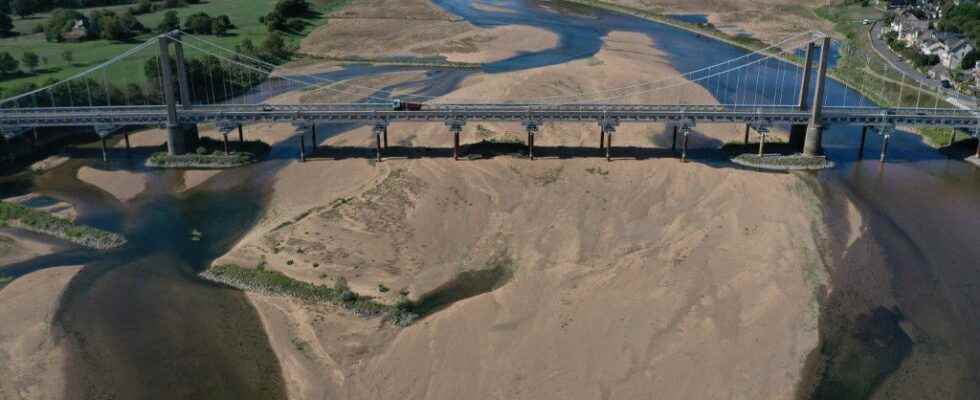The rain has been making a strong comeback for several weeks in France. But will this precipitation be sufficient to reinflate the many rivers and groundwater tables which are experiencing particularly severe drops for the season? If it is still too early to know if France will again experience a year of exceptional drought after 2022, the forecasts of the Bureau of Geological and Mining Research (BRGM), do not bode well for the availability of water. in 2023.
“The levels of the water tables for the month of December are unsatisfactory. Indeed, the rains infiltrated during the autumn are very insufficient to compensate for the deficits accumulated during the year 2022 and to improve the state of the water tables in the long term”, writes the organization. audience in a statement published on January 13. The BRGM thus notes levels “worrying over a large part of the territory”, “historically low in the Alpes-Maritimes”, with however some local exceptions such as Brittany or Alsace.
As of January 16, 4 departments are still on alert (Ille-et-Vilaine, Jura, Lozère and Savoie) and 8 departments are on alert or heightened alert resulting in restrictions (Oise, Deux-Sèvres, Ain, Isère, Lot, Tarn -et-Garonne, Haute-Garonne, Pyrenees-Orientales) according to the government site Propluviawhich lists the drought orders.
For 2023, “we are quite pessimistic”
“The groundwater situation, which represents two-thirds of the withdrawals in France, is much less favorable than at the end of winter 2021-2022” when the water tables were at “roughly correct” levels before that a historic drought does not occur “on the surface”, commented Pierre Pannet, deputy director of BRGM, during a press briefing on January 12. If rain is so rare in 2023, “we will arrive at a much worse situation than the one we experienced at the end of summer 2022”, when almost all metropolitan departments experienced water restrictions, added the expert. .
According to Meteo France, 2022 was indeed the hottest year ever recorded in the country with 14.5 degrees of average annual temperature but also one of the driest, with a rainfall deficit of some 25%. The drought and the summer heat wave have had major repercussions on agriculture or the production of hydraulic and nuclear electricity, with groundwater providing around two-thirds of drinking water and one-third of agricultural irrigation.
“The situation is to be monitored, the precipitation could return to Aude and the Pyrénées-Orientales from January 17, underlines agroclimatology researcher Serge Zaka on Twitter. fauna and flora on the first centimeters of the ground”. According to the BRGM, the autumn rains, on very dry land, in fact first benefited the surface soils and vegetation before recharging the water tables at depth.
For 2023, “we are quite pessimistic because the start of the recharge was very late, more than a month late, the rains are very insufficient and we had a severe low water level in many sectors”, explains Violaine Bault, hydrogeologist at BRGM. However, excess rains are necessary during the winter, because “as soon as the vegetation goes dormant, the rain benefits the soil and manages to infiltrate in depth”, while in “spring, the rains are essentially recovered by the vegetation”, she adds. With the ongoing climate change, “we know with certainty that the periods of drought should be longer and more intense, with milder springs and therefore vegetation which resumes earlier”, recalls the hydrogeologist.
A “water action plan”
Faced with the growing awareness of the French and the concern of local elected officials, the government has included a “water” action plan in its ecological planning exercise under the leadership of Prime Minister Elisabeth Borne. The objectives set out in October aim to “reduce water consumption and optimize withdrawals, better reuse wastewater and accelerate the reduction of leaks in water networks”. Announcements of measures are thus expected on January 26 at the Carrefour des gestions locales de l’eau, in Rennes.
In the meantime, several working groups of the National Water Committee (a body made up of representatives of the State, local elected officials, players in the water sector, users, particularly from the agricultural world, and environmental defense associations) met to study the subject between November and mid-December. Additional studies on the state of the resource, public awareness of sobriety, management of the volumes of water used from the month of March to limit the impact of summer droughts, sharing of water withdrawal data in the environment, strengthening of controls… The summary of these exchanges was returned to the Secretary of State to the Minister for Ecological Transition, Bérangère Couillard, at the beginning of January.
For Agathe Euzen, director of research and head of the water unit at the CNRS, who co-leads one of the six “water plan” working groups, there is an urgent need for all the players in the territories to change the management of this resource. “Due to climate change, the seasons are no longer as obvious as before, the rhythms and densities of precipitation are disrupted even as the demand for water increases. This has an impact on the environments and human activities that they be industrial, agricultural or domestic, insofar as we used to withdraw water without considering the renewability and quality of natural stocks. of this precious resource, even in the short term, in certain regions. It is absolutely necessary to reconsider the uses and withdrawals, according to the availability of the resource and the capacity of the environment to regenerate, and no longer by considering that water is completely unlimited, explains the researcher. This will create real upheavals since we are on economic development models that do not necessarily take availability into account. é of the resource. But we no longer have a choice and scientists are mobilizing to provide the latest knowledge to support these transitions in dialogue with the actors.”
